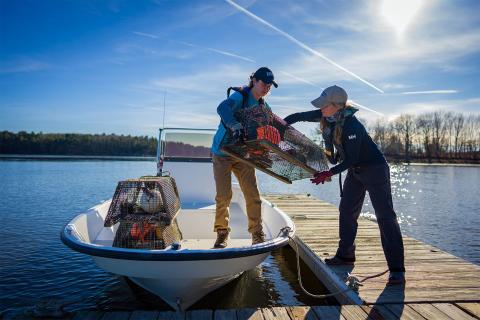Supporting New Hampshire’s Shellfish Farmers
When she’s not collecting invasive green crabs — and the now emerging blue crabs — in New Hampshire’s Great Bay Estuary or working in the lab of Bonnie Brown, professor of ecological genetics and chair of COLSA’s department of biological sciences, marine biology doctoral student Kelsey Meyer shares the stories of the region’s shellfish farmers.
As coordinator of the NH Shellfish Farmers Initiative (NHSFI), Meyer has met with some of the state’s foremost legislators and legislative staff, including U.S. Representative Chris Pappas and staffers for Governor Chris Sununu and U.S. Senator Maggie Hassan, to speak about the critical role oyster farming can play in driving aquaculture sector growth and how oysters offer a myriad of ecological benefits, like filtering water and supporting the health of native marine life.
“With NHSFI, the farmers and I help fill that gap, letting people know what’s involved in oyster farming and how oysters offer so many environmental benefits besides just being a delicious seafood.”
“The general public doesn’t typically know the value of New Hampshire’s oyster farms,” says Meyer. “With NHSFI, the farmers and I help fill that gap, letting people know what’s involved in oyster farming and how oysters offer so many environmental benefits besides just being a delicious seafood.”
“In New Hampshire, the oyster industry is fairly new, especially compared to Maine and Massachusetts,” she adds. “We’re really raising awareness about the state’s oyster aquaculture, how important it is, and that we have a lot of great local oyster farming businesses.”
Meyer began her Ph.D. in marine biology at the University of New Hampshire in 2020. Shortly after, she started collecting and studying invasive crabs and their impacts on the local shellfish industry in the Great Bay Estuary. As she began working on different shellfish research and outreach initiatives in the community, she connected with the grassroots NHSFI, eventually taking on the coordinator role with plans to run it full-time once she graduates from UNH. In just a short amount of time, Meyer has become a key advocate for the Granite State’s oyster farmers by spreading the word about the benefits of raising the shellfish, which she’s done at events and organizational meetings up and down the New Hampshire and Southern Maine seacoasts. She also helps organize the annual New Hampshire Oyster Week, which celebrated its second year in September 2022.
One of the region’s foremost outreach events for oyster aquaculture, New Hampshire Oyster Week lets oyster farmers directly connect with consumers while also providing a venue to highlight NHSFI-supported oyster aquaculture and restoration projects. Among these are The Nature Conservancy-funded Supporting Oyster Aquaculture and Restoration (SOAR) project and a USDA Natural Resources Conservation Service (NRCS)-funded Environmental Quality Incentives Program (EQIP). Both efforts focus on purchasing surplus oysters and large, unmarketable oysters (known as “uglies”) and deploying them at restoration sites near Great Bay’s Nannie Island.
Since 2019, nearly a million surplus and/or unmarketable farmed oysters have been added across 12 acres of restoration sites near Nannie Island, enhancing the natural existing reefs and providing critical habitat for oyster larvae, or spat, as well as fish and invertebrates. This work has involved oyster farmers from across Great Bay and UNH researchers at Jackson Estuarine Laboratory, among them Ray Grizzle, research professor of biological sciences, and Krystin Ward, laboratory research supervisor and owner/operator of Choice Oysters.
Their efforts have paid off.
“Sampling in 2021 and 2022 turned up a lot of newly set spat in the areas where we had put farmed oysters down after not seeing any for about three years,” says Ward. “We also found spat on the surrounding clam shells that we put down to extend the edges of the natural reef. All this is good news!”
At NHSFI, part of Meyer’s mission is highlighting the work of SOAR and the NRCS, and how these collaborative restoration projects serve the needs of shellfish farmers, environmentalists and conservationists, local landowners, policy leaders and seafood consumers.
“Oysters are a keystone species — they help with shoreline protection and, as filter feeders, they help improve water quality and clarity. They’re integral to keeping Great Bay a healthy ecosystem — and that’s something that I think we can all agree is very important.”
“Oysters are a keystone species — they help with shoreline protection and, as filter feeders, they help improve water quality and clarity,” Meyer explains. “They’re integral to keeping Great Bay a healthy ecosystem — and that’s something that I think we can all agree is very important.”
You can learn more about NHSFI by visiting www.nhsfi.com.
